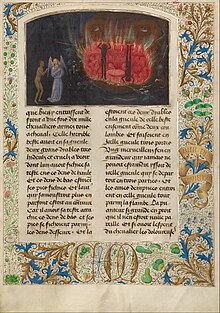Getty Tondal


Les Visions du chevalier Tondal is an illuminated manuscript from 1475, now at the Getty Museum, of a French version of the "Visio Tnugdali", of which it is the only fully illuminated manuscript to survive. It has 20 miniatures by Simon Marmion and elaborate borders with "CM" for the initials of Margaret of York, duchess of Burgundy and her husband Charles the Bold. The text was scribed by David Aubert in Ghent, whilst the miniatures were done in Valenciennes, where Marmion was based.[1] Only the pages with the 15 two column miniatures and five single column miniatures have borders, but as there are only 45 folios, the illumination is very full. The manuscript is fully available online.[2]
The work
The Visions of the Knight Tondal or "Visio Tnugdali", was written in Latin in the 12th century by an Irish monk named Marcus in Regensburg, where there was an Irish monastery. It was "the most popular and elaborate text in the medieval genre of visionary infernal literature" and had been translated forty-three times into fifteen languages by the 15th century,[3] including Icelandic and Belorussian.[4] It may have been part of the inspiration for Dante's journey into hell, purgatory and heaven.
In the story, Tondal is a wealthy Irish knight who passes out at a feast and goes into a deep dream-journey through Hell, Heaven and Purgatory (never so named – the doctrine was still in development), guided by an angel. The experience turns Tondal into a pious man. The story is set in Cork, Ireland in 1148, and claims to be a translation of an original in the Irish language, which however has not survived.[4]
The miniatures
Titles by the Getty, 19/20 listed,:[5]
- Tondal Suffers a Seizure at Dinner
- Tondal Appears Dead
- The Valley of Murderers
- The Mountain of Unbelievers and Heretics
- The Valley of the Perversely Proud and Presumptuous
- The Beast Acheron, Devourer of the Avaricious
- The Nail-Studded Bridge for Thieves and Robbers
- The House of Phristinus; Punishment for Gluttons and Fornicators
- The Beast that Eats Unchaste Priests and Nuns
- The Forge of Vulcan; Punishment for Those who Commit Evil upon Evil
- Demons Dragging Tondal into the Infernal Cistern
- The Gates of Hell and Lucifer
- The Wall of Heaven Where the Bad but Not Very Bad Are in Temporary Discomfort
- The Good but Not Very Good Are Nourished by a Fountain
- Two Kings of Ireland, Former Enemies, Who Made Peace before Death
- The Happy Crowds of the Faithfully Married
- The Martyrs and the Pure Sing Praises to God
- The Glory of Good Monks and Nuns
- The Wall of Metals and Jewels surrounding Angels and Saints
Notes
- ^ Kren & S McKendrick, 112–116
- ^ The Getty Museum manuscript; click box to right for page by page view
- ^ Kren & S McKendrick, 112. 43 from Easting
- ^ a b Easting, 70
- ^ Getty Press release
References
- T Kren & S McKendrick (eds), Illuminating the Renaissance: The Triumph of Flemish Manuscript Painting in Europe, Getty Museum/Royal Academy of Arts, pp. 112–116 & passim, 2003, ISBN 1-903973-28-7
- Easting, Robert. Visions of the Other World in Middle English, 1997, Boydell & Brewer, ISBN 0-85991-423-2 [1]
Further reading
- Kren, Thomas, ed. Margaret of York, Simon Marmion, and The Visions of Tondal. Malibu, CA, J. Paul Getty Museum, 1992.
- Kren, Thomas and Roger Wieck. The Visions of Tondal from the Library of Margaret of York. Los Angeles, CA: J. Paul Getty Trust, 2012. E-Book.
